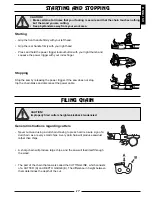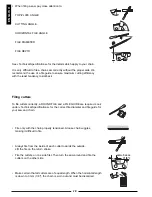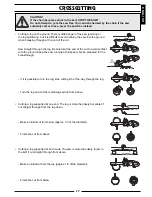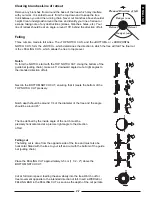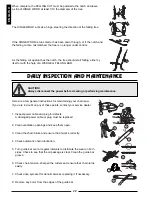
8
ENGLISH
KICKBACK PREVENTION
DANGER!
Kickbacks occur suddenly and without warning. A kickback may be violent enough
to throw a chainsaw back at the user. A running chain can inflict severe and even
fatal injury. It is imperative for users to be familiar with the causes of kickbacks in
order to exercise the proper care and use working techniques to prevent kickback.
CAUTION!
Improperly sharpened cutters or the wrong chain and guide bar combination will
increase the risk of kickback.
See «Technical Specifications» on page 3.
CAUTION!
Do not let the chain come in contact with the ground or any objects.
Chain link and wire fencing materials present a particular kickback hazard.
Observe all safety rules in order to avoid kickbacks and other accidents which
may cause injury.
•
A kickback is a sudden reaction in which a chain saw is thrown back as
a result from contact with the upper part of the bar nose known as the
kickback danger zone.
•
The direction of a kickback is always in the same plane as the guide bar.
The most common reaction is that the guide bar and saw are thrown up and
back towards the operator. The saw can be thrown in other directions, too,
however, depending on the position of the saw at the moment of kickback.
Basic rules
•
Knowing the cause and nature of a kickback helps reduce or eliminate the element of surprise.
Surprise increases the danger of an accident. Most kickbacks are small, but some are violent, and
all are lightning-fast.
•
Always grip the chain saw firmly with thumb and fingers wrapped around the handles, right hand on the
rear handle and left hand on the front handle. All users, whether right or left-handed, must use this grip,
which will reduce the effect of a kickback and help keep the saw under control.
Do not let go of the chain saw handles!


















